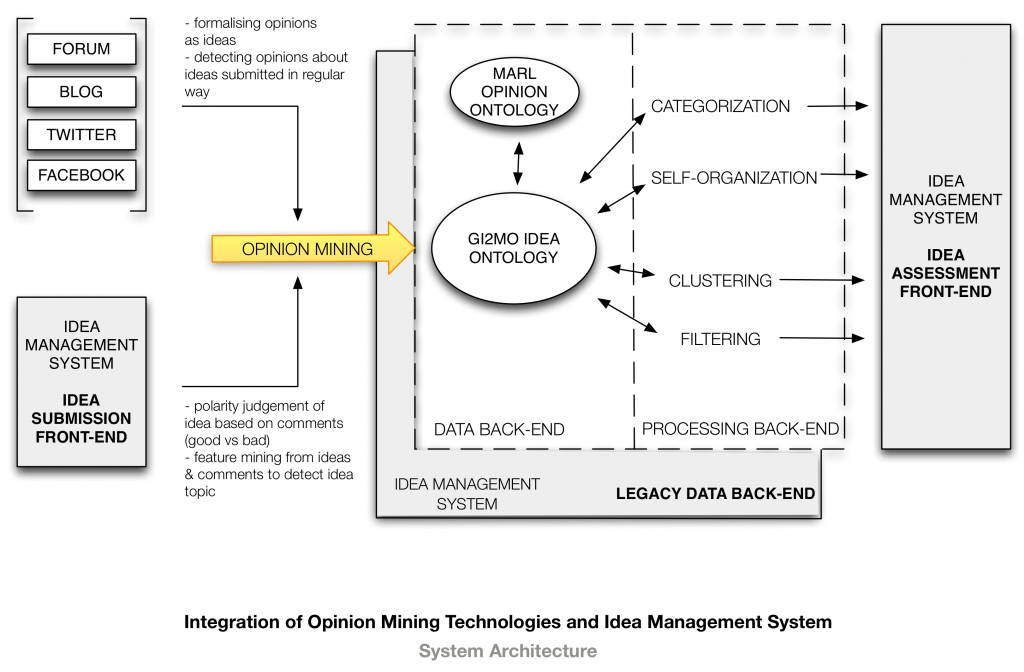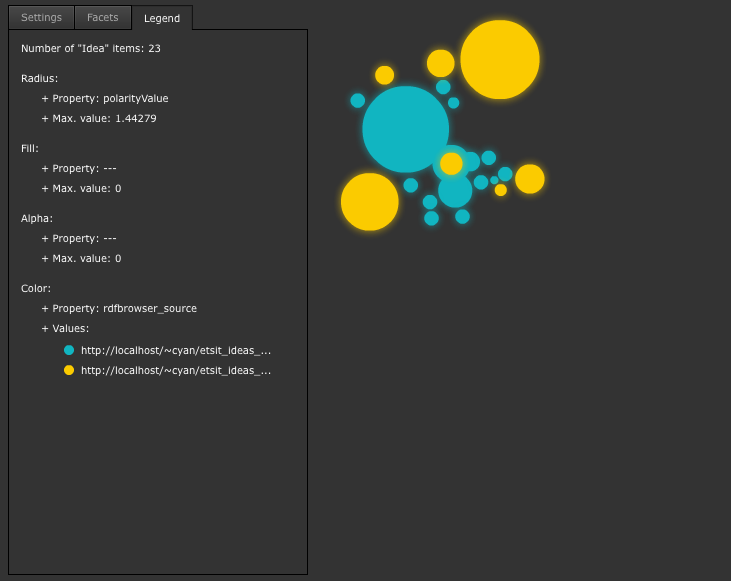A large part of what Idea Management is about is the communities and people that produce the ideas – without them non of this would work. In the following page we discuss the techniques for modelling community created data to enhance contemporary Idea Management Systems.
1. Introduction
On one side the Idea Management instances achieve to collect large amounts of ideas and comments because its very easy to create this content for users but on the other hand later the analysis of all this information can prove very time consuming and diffucult.
As one of the solutions to that we problem see the use of Natural Language Processing algorithms and specifically Opinion Mining. In our opinion automatic recognition of topics on which users comment and the emotions that they express about certain ideas can work as an additional ranking tool beside the traditional community up/down voting.
In Gi2MO research we do not devote to creating accurate Opinion Mining algorithms but only on analysis of the metadata that is delivered during this process and the possible benefits that it can bring to Idea Management Systems.
2. How can Natural Language Processing help
3. Why to publish opinion data in the open
As part of Gi2MO research we investigated what kind of metadata to use and how to publish information about user opinions on the Web. The result is Marl ontology and series of experiments that followed (see Marl use cases, Marl mappings experiments and Linked Opinion query experiments).
We see the point of doing in context of Idea Management for two reasons:
- Publishing data in the open to improve visibility in search engines of the Idea Management instance and products related to it
- Linking detailed opinion metadata with other Idea Management data to achieve better search capabilities and bring new data analysis possibilities (just like we did it with Linked Enterprise data)
4. How to link data and use for own benefits
The goal of Gi2MO ontology is to cover in a generic way the data derived from standard functionalities of Idea Management Systems. Therefore, for opinion polarity (good vs. bad), opinion value (quantified expression of the opinion) and the topic of the opinion we recommend Marl Ontology. This schema was designed specifically for such use and covers a variety of scenarios.
| Field/concept | Ontology property | |
| Connect comment with opinion data | marl:extractedFrom / marl:hasOpinion | |
| Express opinion polarity | marl:hasPolarity | |
| Express opinion polarity value | marl:polarityValue | |
| Opinion topic | marl:describesObject, marl:describesObjectPart, marl:describesFeature | |
For Idea Management System the simplest case is to link and exploit opinions is by applying the Gi2MO and Marl ontologies together and link the opinions indirectly to ideas via comments. Gi2MO delivers the metadata that links comments together with ideas. The same link can be used to extract opinion value for each comment and aggregate the data. Marl provides a metadata class for this use called: marl:AggregatedOpinon. This class can be directly attached to the idea metadata.
For a more sophisticated use opinions can be linked via the topics that they describe, e.g. the specific product that a given opinion describes.
In both cases, establishing such links enriches the metadata structure of Gi2MO and enables to make queries related to opinion content of the Idea Management System user base (e.g. show all positive opinions on ideas related to given product, calculate amount of positive vs. negative opinions connected to given idea or idea category etc.).
5. Usage Example
Context: One of the use cases that could prove the worthiness of Linked Opinions concept is integration of multilingual Idea Management instances that gather ideas on the same topics but from different audience.
Real World Use Case: As an example we use our ETSIT Ideas instance that gathers ideas about improving the university school. Originally we had setup the instance for Spanish students of ETSIT school, however (particular for this experiment) we proposed a second instance in English for international students and interns that visit the university for short period. This way we end up with two systems gathering the exact same input but from different audience and in different languages.
Problem: How to analyse and track all the data in one place and use a single analytical tool for joint analysis of the entire idea stream from both instances.
Solution:
- Gi2MO ontology – is used to describe the data schema from two different systems in the same way, so that two separate data silos can be integrated
- Marl ontology – is used to describe and publish metadata of the opinions in each of the systems
- ATOS PGI 2.0 & Gi2MO IdeaStream – ATOS PGI is used to host the Spanish Idea Management System, while IdeaStream is used for the English one
- OPAL – uses opinion mining to judge the polarity of opinions and transform the problem from text analysis to number comparison
- RDFme – is used to export all the data and make it portable so that in can be analysed with external tools
- Idea Browser & Idea Analyst – are used to visualise and compare data from both of our instances
attached to a particular idea – biggest spheres are ideas with best opinions, colours represent different systems/languages.

